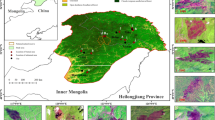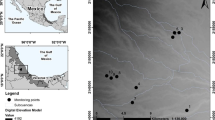Abstract
A number of forests in agroforestry environments are at risk due to urban development or agricultural expansion. These forests often consist of patches of wooded areas scattered in the agricultural and urban grid, and often constitute green corridors that enable a flow between animal and plant species (migration corridors). This study evaluates the composition and structure of riparian forests in agroforestry areas that are subject to various natural and anthropogenic disturbances. This study aims to understand the dynamics of these riparian forest populations and evaluate the effects of the disturbances on the tree stands (e.g. floods, partial cutting), while taking into account their development over space and time based on a diachronic assessment from 1945 to 2010. Although these woodlands are subject to various disturbances, a fairly large diversity of tree species can be noted, and the regeneration of the saplings and small trees follows a normal growth curve (asymmetric) with a high contingency of young tree population comparable to a typical reverse-J distribution. However, lower densities are observed for riparian stands subject to frequent flooding, which could over time compromise recruitment and forest regeneration for some tree species (e.g. woody plants with weak adaptive strategies). The multivariate analyses (Redundancy Analysis and Canonical Correspondence Analysis) conducted over all the soil, environmental and forest data reveal that some variables are more strongly related to the composition of the forest populations, including pH, ground litter and soil drainage. However, these variables must still be considered as being part of a set of interacting soil conditions. Lastly, the future of these woodlands may appear uncertain because there are no government policies or measures to ensure their protection and preservation.






Similar content being viewed by others
References
Asaeda T, Pattiyage I, Gomes A, Takeda E (2010) Spatial and temporal tree colonization in a midstream sediment bar and the mechanisms governing tree mortality during a flood event. River Res Appl 26:960–976
Barnett TP, Pierce DW, Hidalgo HG, Bonfils C, Santer BD, Das T, Bala G, Wood AW, Nozawa T, Mirin AA, Cayan DR, Dettinger MD (2008) Human-induced changes in the hydrology of the western United States. Science 319:1080–1083
Bellavance C, Saint-Laurent D (2013) Les grandes formes du paysage centricois. In: Bellavance C, Rousseau Y and Roy J (eds) Histoire du Centre-du-Québec, Chap. 1, Presses de l’Université Laval, Québec
Bendix J, Cowell CM (2013) Disturbance and riparian tree establishment in the Sespe Wilderness, California, USA. Phys Geogr 34:149–158
Bendix J, Hupp CR (2000) Hydrological and geomorphological impacts on riparian plant communities. Hydrol Proc 14:2977–2990
Berthelot JS, Saint-Laurent D, Gervais-Beaulac V, Savoie D (2014) Assessing the effects of periodic flooding on the population structure and recruitment rates of Riparian tree forests. Water 6:2614–2633
Biswas SR, Mallik AU (2010) Disturbance effects on species diversity and functional diversity in riparian and upland plant communities. Ecology 91:28–35
Blöschl G, Ardoin-Bardin S, Bonell M, Dorninger M, Goodrich D, Gutknecht D, Matamoros D, Merz B, Shand P, Szolgay J (2007) At what scales do climate variability and land cover change impact on flooding and low flows? Hydrol Proc 21:1241–1247
Bornette G, Tabacchi E, Hupp C, Puijalon S, Rostan JC (2008) A model of plant strategies in fluvial hydrosystems. Fresh Biol 53:1692–1705
Brady N, Weil R (2008) The nature and properties of soils. Pearson, fourteenth edition, Columbus, OH, USA
Camporeale C, Perucca E, Ridolfi L, Gurnell AM (2013) Modeling the interactions between river morphodynamics and riparian vegetation. Rev Geophys 51:379–414
Carter MR, Gregorich EG (eds) (2008) Soil sampling and methods of analysis. Canadian society of soil science, 2nd edn. Lewis Publishers, Boca Raton, Fl
Castonguay S, Saint-Laurent D (2009) Reconstructing reforestation: changing land use patterns along the Saint-François River in the Eastern Townships. In: MacEachern A, Turkel EJ (eds) Method and meaning in Canadian environmental history. Th. Nelson, Toronto, pp 273–292
Cooper DJ, Andersen DC, Chimner RA (2003) Multiple pathways for woody plant establishment on floodplains at local to regional scales. Ecology 91:182–196
CSSC Canadian System of Soil Classification (1998) Agriculture and agri-food Canada, 3rd edn. Government of Canada
DeFerrari CM, Naiman RJ (1994) A multi-scale assessment of the occurrence of exotic plants on the Olympic Peninsula, Washington. J Veg Sci 5:247–258
EC-MEF Environment Canada and Ministry of Environment of Québec (1982) Flood risk map : Saint-François River Québec. Government of Canada and Ministry of Environment, Québec
Goodburn JM, Lorimer GG (1999) Population structure in old-growth and managed northern hardwoods: an examination of the balanced diameter distribution concept. For Ecol Manag 118:11–29
Husch B, Beers TW, Kershaw JA Jr (eds) (2003) Forest mensuration, 4th edn. Wiley, Hoboken, USA
Junk WJ (1989) Flood tolerance and tree distribution in central Amazonian floodplains. In: Holm-Nielson LB, Nielsen IC, Balslev H (eds) Tropical forests: botanical dynamics, speciation & diversity. Academic Press, pp 47–64
Keddy P (2011) Wetland ecology: principles and conservation. Cambridge University Press, Cambridge, UK
Lassoie JP, Buck LE (1998) Exploring the opportunities for agroforestry in changing rural landscapes in North America. Agrofor Syst 44(2):107–108
Legendre P, Legendre L (1998) Numerical ecology—developments in environmental modelling. Elsevier, Oxford, UK
Maeglin RR, Ohmann LF (1973) Boxelder (Acer negundo): a review and commentary. Bull Torrey Bot Club 100(6):357–363
Malanson G (1993) Riparian landscapes. Cambridge University Press, Cambridge, UK
Marzano R, Lingua E, Garbarino M (2012) Post-fire effects and short-time regeneration dynamic following high severity crown fires in a Mediterranean forest. Forests 5:93–100
McKeague JA (1978) Manual on soil sampling and methods of analysis, 2nd edn. Canadian Society of Soil Science, AAFC, Ottawa, Ontario, Canada
MDDELCC Ministère du Développement durable, Environnement et Lutte contre les changements climatiques (2015) Normales Climatiques du Québec 1981–2010. Gouvernement du Québec, 2015. http://www.mddelcc.gouv.qc.ca/climat/normales/sommaire.asp
Menges ES, Waller DM (1983) Plant strategies in relation to elevation and light in floodplain herbs. Am Nat 122:454–473
Mouw JEB, Stanford JA, Alaback PB (2009) Influences of flooding and hyporheic exchange on floodplain plant richness and productivity. River Res Appl 25:929–945
MERN Ministère de l’Énergie et Ressources naturelles (2010) Production d’orthographies numériques. Gouvernement du Québec. https://www.mern.gouv.qc.ca/territoire/expertise/ expertise-production.jsp
Nilsson C, Berggren K (2000) Alterations of riparian ecosystems caused by river regulation. Bioscience 50:783–792
Oksanen J, Blanchet FG, Kindt R, Legendre P, Minchin PR, O’Hara RB, Simpson GL, Solymos P, Stevens MHH, Wagner H (2015) Vegan: Community Ecology Package, R Package Vegan, v. 2.2-1. http://outputs.worldagroforestry.org/cgi-bin/koha/opac-detail.pl?biblionumber=39154
Palmer MA, Lettenmaier DP, Poff NL, Postel SL, Richter B, Warner R (2009) Climate change and river ecosystems: protection and adaptation options. Environ Manag 44:1053–1068
Planty-Tabacchi AM, Tabacchi E, Naiman RJ, DeFerrari C, Decamps H (1996) Invasibility of species-rich communities in riparian zones. Conserv Biol 10:598–607
PRDIRT Plan régional de développement intégré des ressources naturelles et du territoire (2011) Portrait de la forêt naturelle du Centre-du-Québec. http://www.cre.centre-du-quebec.qc.ca/client/uploads/317/103942213210642.pdf
PRDIRT Plan régional de développement intégré des ressources naturelles et du territoire (2015) Portrait de la forêt naturelle et des enjeux écologiques de l’Estrie. http://www.agenceestrie.qc.ca/Documents_PDF/Rapport.Precolonial-Estrie_version2015.pdf
Quikchem Automated Ion Analyzer Methods Manual. No. 13-107-06-2-D (1996) Determination of total Kjeldahl nitrogen in soils and plants by flow injection analysis (block digester method). LACHAT Instruments, Milwaukee, WI
R Core Team (2015) A Language and environment for statistical computing. R Foundation for Statistical Computing, Vienna, Austria
Richardson D, Holmes P (2007) Riparian vegetation: degradation, alien plant invasions, and restoration prospects. Divers Distrib 13:126–139
Roxburgh SH, Shea K, Wilson JB (2004) The intermediate disturbance hypothesis: patch dynamics and mechanisms of species coexistence. Ecology 85:359–371
Saint-Laurent D, Gervais-Beaulac V, Berthelot JS (2014) Variability of soil properties in different flood-risk zones and link with hydroclimatic changes (Southern Québec, Canada). Geoderma 214(215):80–90
Sparks RE, Bayley PB, Kohler SL, Osborne LL (1990) Disturbance and recovery of large floodplain rivers. Environ Manag 14:699–709
Tanentzap AJ, Lee WG, Schulz KAC (2013) Niches drive peaked and positive relationships between diversity and disturbance in natural ecosystems. Ecosphere 4:1–28
Turner MG, Gergel SE, Dixon MD, Miller JR (2014) Distribution and abundance of trees in floodplain forests of the Wisconsin River: environmental influences at different scales. J Veg Sci 15:729–738
Ward J, Tockner K, Schiemer F (1999) Biodiversity of floodplain river ecosystems: ecotones and connectivity. Regul Rivers 15:125–139
Ward JV, Tockner K, Arscott DB, Claret C (2002) Riverine landscape diversity. Fresh Biol 47:517–539
Wolters V, Joergensen RG (1991) Microbial carbon turnover in beech forest soils at different stages of acidification. Soil Biol Biochem 23:897–902
Yeomans JC, Bremner JM (1988) A rapid and precise method for routine determination of organic carbon in soil. Commun Soil Sci Plant Anal 19:1467–1476
Zelnik L, Cami A (2008) Distribution of plant communities, ecological strategy types and diversity along a moisture gradient. Community Ecol 9:1–9
Acknowledgements
We would like to thank NSERC (Natural Sciences and Engineering Research Council of Canada) for financial support of this research (NSERC-RGPIN-2016-2021). We sincerely thank the Editor-in-Chief, Dr. Shibu Jose, and also the reviewers for their helpful comments. We thank A. Brousseau (U. Laval) for their assistance in soil analysis, and C. Martin (UQTR) for help in statistical analysis. We thank also C. Ouellet, L. Pelletier, I. Bazier and D. Savoie for their field assistance.
Author information
Authors and Affiliations
Corresponding author
Rights and permissions
About this article
Cite this article
Saint-Laurent, D., Berthelot, JS. & Gervais-Beaulac, V. Habitat fragmentation and structure and composition of tree populations in a agroforestry landscape (southern Québec, Canada). Agroforest Syst 92, 1517–1534 (2018). https://doi.org/10.1007/s10457-017-0099-0
Received:
Accepted:
Published:
Issue Date:
DOI: https://doi.org/10.1007/s10457-017-0099-0




